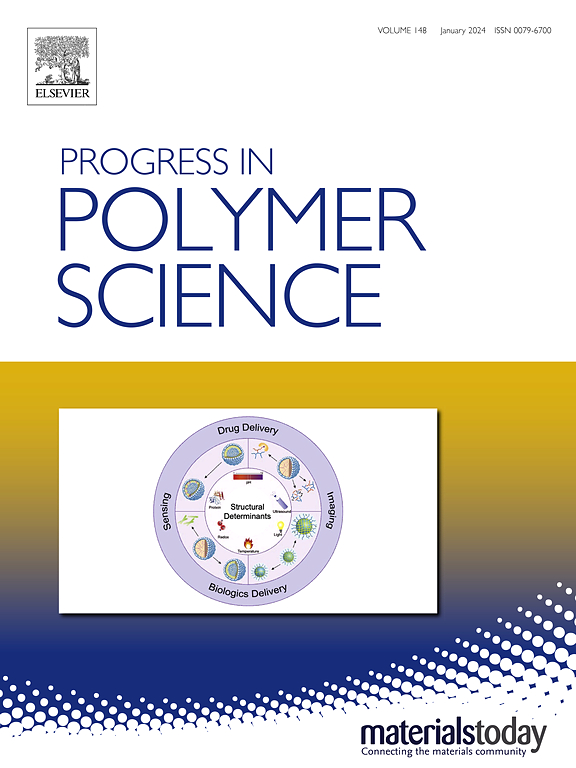Discreteness and dispersity in the design of polymeric materials
IF 26.1
1区 化学
Q1 POLYMER SCIENCE
引用次数: 0
Abstract
Nature produces macromolecules with discrete molar mass and precise composition, both of which are essential for ensuring structural control, distinctive properties, and specific functions. However, in some cases, bioderived components are heterogeneous in size, and this plays a crucial role in defining their physicochemical characteristics. In a similar way, polymer scientists have been striving to develop robust synthetic protocols to access macromolecules with homogeneous composition and discrete molar mass. Simultaneously, significant advances in controlled polymerization techniques have enabled the precise regulation of chain length heterogeneity, or dispersity (Đ), across a wide range of values. Achieving perfectly monodisperse polymers is not only a remarkable synthetic achievement but also provides fundamental building blocks for new classes of polymeric materials. These materials could be either free of defects or exhibit properties that are precisely tunable in a quantized manner. On the other hand, obtaining polymer samples with controlled dispersity provides an additional tuning parameter for the physicochemical properties of a variety of materials formulations. By leveraging macromolecular discreteness and fine-tuning polymer dispersity, we have expanded the toolbox for designing advanced “soft” materials. Block copolymers with discrete segment lengths or controlled dispersity can be used to create novel nanostructured materials. Stimuli-responsive polymeric systems can be engineered to precisely adjust their physical transitions while maintaining a constant chemical composition. In addition, tailoring polymer dispersity during the fabrication of gels and brush coatings enhances the ability to fine-tune their physicochemical properties, further broadening their potential applications.


高分子材料设计中的离散性与分散性
大自然产生的大分子具有离散的摩尔质量和精确的组成,这两者对于确保结构控制、独特性质和特定功能都是必不可少的。然而,在某些情况下,生物衍生成分在尺寸上是不均匀的,这在确定其物理化学特性方面起着至关重要的作用。类似地,聚合物科学家一直在努力开发强大的合成方案,以获得具有均匀组成和离散摩尔质量的大分子。同时,控制聚合技术的重大进展已经能够精确调节链长非均质性或分散性(Đ),范围很广。实现完美的单分散聚合物不仅是一项了不起的合成成就,而且为新型聚合物材料提供了基本的构建模块。这些材料要么没有缺陷,要么表现出以量子化方式精确可调的特性。另一方面,获得分散可控的聚合物样品为各种材料配方的物理化学性质提供了额外的调整参数。通过利用大分子的离散性和微调聚合物的分散性,我们已经扩展了设计先进“软”材料的工具箱。具有离散段长度或控制分散性的嵌段共聚物可用于制造新型纳米结构材料。刺激响应聚合物系统可以设计成精确地调整其物理转变,同时保持恒定的化学成分。此外,在凝胶和刷刷涂层的制造过程中,调整聚合物的分散性可以提高其物理化学性质的微调能力,进一步扩大其潜在的应用范围。
本文章由计算机程序翻译,如有差异,请以英文原文为准。
求助全文
约1分钟内获得全文
求助全文
来源期刊

Progress in Polymer Science
化学-高分子科学
CiteScore
48.70
自引率
1.10%
发文量
54
审稿时长
38 days
期刊介绍:
Progress in Polymer Science is a journal that publishes state-of-the-art overview articles in the field of polymer science and engineering. These articles are written by internationally recognized authorities in the discipline, making it a valuable resource for staying up-to-date with the latest developments in this rapidly growing field.
The journal serves as a link between original articles, innovations published in patents, and the most current knowledge of technology. It covers a wide range of topics within the traditional fields of polymer science, including chemistry, physics, and engineering involving polymers. Additionally, it explores interdisciplinary developing fields such as functional and specialty polymers, biomaterials, polymers in drug delivery, polymers in electronic applications, composites, conducting polymers, liquid crystalline materials, and the interphases between polymers and ceramics. The journal also highlights new fabrication techniques that are making significant contributions to the field.
The subject areas covered by Progress in Polymer Science include biomaterials, materials chemistry, organic chemistry, polymers and plastics, surfaces, coatings and films, and nanotechnology. The journal is indexed and abstracted in various databases, including Materials Science Citation Index, Chemical Abstracts, Engineering Index, Current Contents, FIZ Karlsruhe, Scopus, and INSPEC.
 求助内容:
求助内容: 应助结果提醒方式:
应助结果提醒方式:


